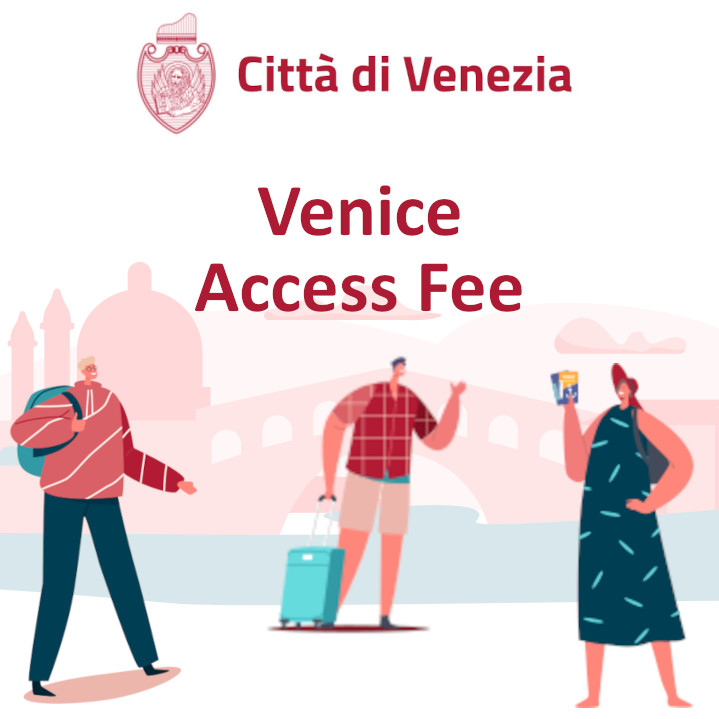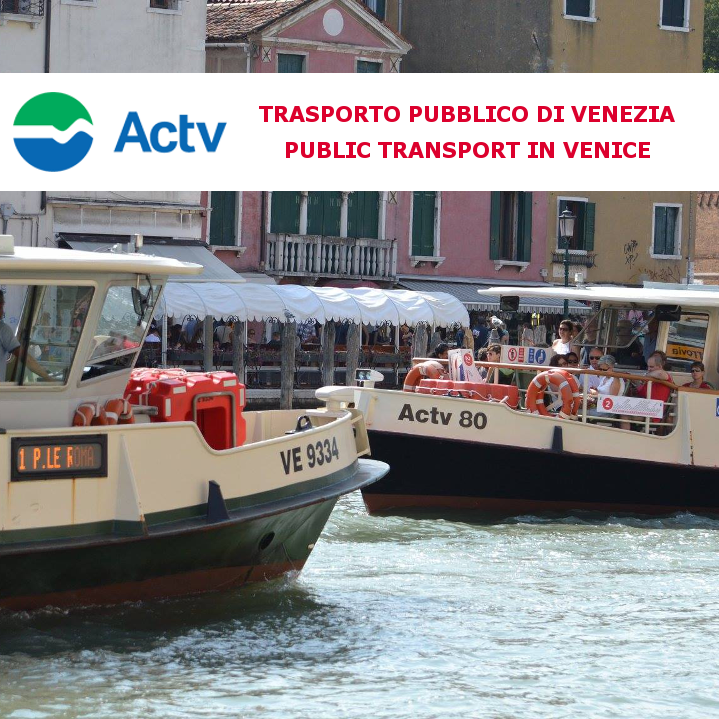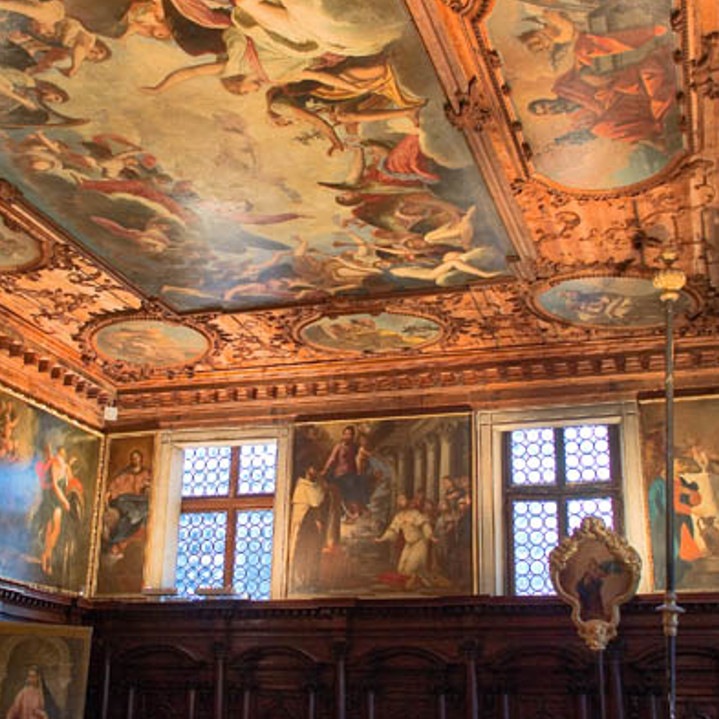You are here
The Sestiere of Cannaregio
THE SESTIERE OF CANNAREGIO
3rd Itinerary
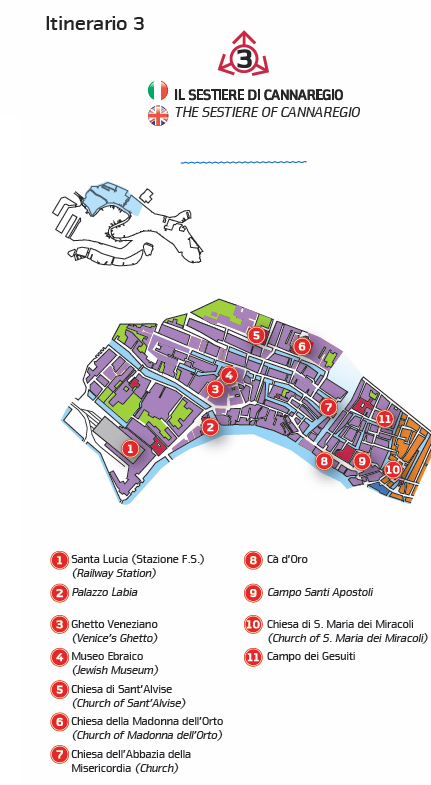 The itinerary proposes an alternative route to the better-known one of the Strada Nova. As well as visits to the main churches, walks along the alleys and waterside pavements (fondamente), we also recommend some points for taking in some spectacular views of the lagoon. The Sestiere, or district, of Cannaregio occupies the north-western part of Venice and extends from the Grand Canal to the lagoon. Still a densely populated part of town today, this Sestiere was historically divided into two: an older one towards the Grand Canal with its sumptuous palaces, and the more recent and less-affluent one, which grew mainly in the 1600 and 1700s.
The itinerary proposes an alternative route to the better-known one of the Strada Nova. As well as visits to the main churches, walks along the alleys and waterside pavements (fondamente), we also recommend some points for taking in some spectacular views of the lagoon. The Sestiere, or district, of Cannaregio occupies the north-western part of Venice and extends from the Grand Canal to the lagoon. Still a densely populated part of town today, this Sestiere was historically divided into two: an older one towards the Grand Canal with its sumptuous palaces, and the more recent and less-affluent one, which grew mainly in the 1600 and 1700s.
Starting from the railway station (Santa Lucia) and walking along the Lista di Spagna to Campo San Geremia, we keep to the right towards the center of the square. Opposite right is the imposing Palazzo Labia, built in the late 17th and early 18th centuries and bought as the prestigious residence of the Labia family, who were wealthy Catalan merchants raised to noble rank in the mid 1600s. The family invested greatly in enhancing the Palazzo’s interiors, paying the best artists of the times, not least of whom Giambattista Tiepolo. That artist was indeed responsible for the large cycle in the ballroom dedicated to Cleopatra (the Triumph of Apollo on the ceiling and wall, the Meeting of Anthony and Cleopatra, and the Banquet of Cleopatra). A part of the palace is currently the regional seat of Italy’s state broadcaster, RAI. After leaving Campo San Geremia, we enter the quieter and more characteristic zones. The first bridge to cross is Ponte delle Guglie (the bridge of the spires) built in 1580 as a replacement of a former wooden bridge. It takes its name from its four spires on the parapets, placed there in 1823 during the latest restoration. Before starting the visit to the Ghetto zone, it is worth walking farther along the Fondamenta di Cannaregio to the Ponte dei Tre Archi. Designed by Andrea Tirali in 1688, like the Guglie, this interesting bridge was also named descriptively, for its three-arch structure.
Returning towards the Ponte delle Guglie and turning into the Calle del Ghetto Vecchio, we come to the Venice’s old Ghetto, where in 1516, the senate of the Republic decreed that all of Venice’s Jewish people had to live in this small insula or island surrounded by a sort of moat on all sides with only two access bridges which were guarded at the night. The area is immediately recognizable for its very tall buildings, which were thus constructed to house as many people as possible. This process evolved over 200 years, for the Jewish community was prohibited from living elsewhere from 1516 until 1797, so the newer buildings of that period were the tallest. The Jewish Museum (concession with Rolling Card), houses interesting examples of Jewish Venetian art of the 17th-19th centuries. Within the compact architecture of the Ghetto, you can spot small domes, indicating the synagogues, which were also known as Scuole (schools) as they were multi-functional. The most impressive of these is the Scuola Levantina in the Ghetto Vecchio (old Ghetto), which was founded in 1538 and renovated in the 17th century, perhaps on drawings by Baldassarre Longhena. From Campo del Ghetto Nuovo, we cross the bridge which leads to the Fondamenta degli Ormesini, and continue on the left along the fondamenta to the stone bridge. We then continue in the same direction along the narrow calle (alley) opposite the bridge to reach Campo Sant’Alvise, a quiet and solitary square-parvis.
Dating back to the 14th century, the Church of Sant’Alvise (included in the Chorus Circuit, with concession entrance with Rolling Card) contains paintings (reworked in the 17th century) by Giambattista Tiepolo, among which a beautiful Salita al Calvario (Christ on the Road to Calvary) (1743) on the right wall of the presbytery. The nave conserves the original structure of one of the first examples of barco (vaulted choir of the monks), supported by columns, which was directly connected to the adjacent monastery. The Venetian Christian name of Alvise comes from Luigi, the given name of the Bishop of Toulouse to whom the church is dedicated. A short walk on from Sant’Alvise takes us to the Church of Madonna Dell’Orto. Built in the 15th century, it was originally dedicated to St. Christopher. Today’s name instead dates back to the 14th century when, so the tradition goes, a statue of the Virgin with Child was found in a local allotment. The church faces onto a small and enchanting square-parvis. A Gothic-Renaissance portal opens in the brick façade of Romanesque, Gothic and Renaissance features, and embellished with statues. On top of the 15th-century bell tower is a small dome added by Bartolomeo Bon in 1503. The three-aisled church contains paintings by Jacopo Tintoretto, who was buried there in 1594, in the chapel to the right of the presbytery: in the right aisle is a Presentation of Mary at the Temple (1552); in the 4th chapel on the left is The Miracle of St. Agnese (1577); and large canvases in the presbytery (The Universal Judgment and The Worship of the Golden Calf, 1546 circa). The artist lived nearby, across the canal and along the Fondamenta dei Mori. Inside we can also admire, at the first altar on the right, a St. John the Baptist by Cima da Conegliano (1493 circa); and in the Valier Renaissance chapel, the 1st of the left aisle, a Madonna with Child by Giovanni Bellini (stolen in 1993). Walking the winding alleys and crossing the bridges with their delightful views (Ponte di Sacca with a view over the Sacca della Misericordia and across the Lagoon towards Murano island), we arrive at one of the most characteristic and quietest of Venice’s squares: Campo dell’Abbazia and its Chiesa dell’Abbazia della Misericordia, with the Scuola Vecchia della Misericordia beside it. The church (also called Santa Maria di Val Verde), with adjacent abbacy, was founded in the 10th century, rebuilt in the 13th and reconstructed several times afterwards. Making a corner with the Baroque façade (dating 1651-59) on the square that still has its original brick paving, stands the 15th-century front wall of the Scuola Vecchia di S. Maria della Misericordia, built in 1310 and later enlarged several times. The two angels on the portal lintel are all that remains of a relief by Bartolomeo Bon, today conserved at London’s Victoria and Albert Museum. The Scuola has had an eventful history and was for a time owned by a painter Italico Brass, who had it restored to be used as a venue for art exhibitions. Not far away is the Scuola Nuova (new school) of S. Maria della Misericordia, built partly according to drawings by Jacopo Sansovino between 1534 and 1583 but not completed. This large building was built to house the growing number of members of the confraternity in the 16th century. For many years, the seat of the municipal archive and a sporting association, it is currently undergoing restoration. After walking along the Fondamenta di San Felice, we briefly stroll the last section of the Strada Nova to visit the Ca’ d’Oro (literally ‘golden house’). Built for the Contarini family in the Gothic mold by Bartolomeo and Giovanni Bon, and Matteo Raverti (1422-40), together with the Doge’s Palace, this palace is the zenith of ornate Gothic in Venice. Its name derives from the gilding works that decorated its Grand-Canal-facing façade, which is covered with polychrome marble, has a columned portico, two loggias with interwoven arches, delicate balconies and a highly original crenellation. The palace is a remarkable and evocative example of Oriental inspiration, typical of 15th century Venetian Gothic architecture, as is borne out by its architecture, luxurious marbles and the splendid multi-colored facings and gildings (the latter now worn away). The original design was probably to keep in step with the traditional concept of the Venetian palazzo and have a central body flanked by two less important wings. Instead only the right wing was completed, perhaps due to a lack of space. After various events along the way and works of restoration, the palace was bought by the Franchetti family. In 1916, together with its art collection, it was donated to the Italian state and became the first property of the Giorgio Franchetti Gallery. Ca’ D’Oro was converted into a museum in 1927: the collection, along with the furnishings, tapestries and coins includes some important works by Titian, Carpaccio, Mantegna, Giorgione, Cima to name only the most renowned.
Continuing along the Strada Nova, in a few minutes we come to Campo Santi Apostoli with its church (restored in 1575). This is a stop-off on the way to admire the now-close small and isolated church in the homely Campo dei Miracoli. Not far from Campo SS. Apostoli (itinerary: Campiello Casson, San Canciano, Campo Santa Maria Nova, Santa Maria dei Miracoli) is the Church of Santa Maria dei Miracoli (included in the Chorus Circuit, concession entrance with Rolling Card).
The history of the church is linked to a “miraculous” image of the Virgin Mary for which the splendid church was built, with related painting placed on the altar. A genuine Renaissance treasure trove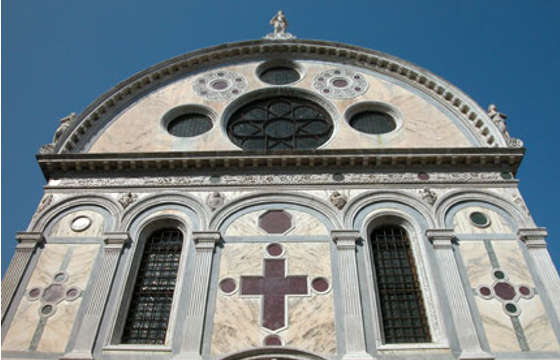 , it is the work of Pietro Lombardo and his workshop of pupils, who inside gave full vent to their artistic skills, providing us with a bewildering array of decorations, engravings, miniaturistically-carved stones and marbles, figures of animals and plants, processions of putti and mermaids, and of prodigious heads and friezes encircling the interior walls. Its polychrome marble facings enliven the elegant architecture of the sides and façade, which is crowned by a semicircular fronton. The interior is refined and elegant, with marble workings, lacunar vault, busts of saints, paintings by P.M. Pennacchi (1528), a raised gallery surrounded by parapet, all replete with fine sculptural decorations by Tullio Lombardo. The barco, or suspended choir above the entrance, has a Madonna with Child by Palma il Giovane. We retrace our steps towards Campo SS. Apostoli to end our walk.
, it is the work of Pietro Lombardo and his workshop of pupils, who inside gave full vent to their artistic skills, providing us with a bewildering array of decorations, engravings, miniaturistically-carved stones and marbles, figures of animals and plants, processions of putti and mermaids, and of prodigious heads and friezes encircling the interior walls. Its polychrome marble facings enliven the elegant architecture of the sides and façade, which is crowned by a semicircular fronton. The interior is refined and elegant, with marble workings, lacunar vault, busts of saints, paintings by P.M. Pennacchi (1528), a raised gallery surrounded by parapet, all replete with fine sculptural decorations by Tullio Lombardo. The barco, or suspended choir above the entrance, has a Madonna with Child by Palma il Giovane. We retrace our steps towards Campo SS. Apostoli to end our walk.
Leaving Campo SS. Apostoli behind, we take the broad thoroughfare of Salizzada del Pistor and follow the recommended route exactly, until a broad square - the Campo dei Gesuiti - opens out before us. Crossing it, heading in the direction of the lagoon, before the church, on the right is the Oratorio dei Crociferi. It was probably founded in the mid 12th century by a small group of monks of the Order of the Crucifers from Rome. In their oratory in Venice, they provided the services of caring for the ill and giving hospitality to pilgrims. In the fifteenth century several renovation works culminated in the decoration of the oratory, entrusted to Jacopo Palma il Giovane, who completed his commission between 1583 and 1592. With strong realism, the eight tapestries on all the walls show the events linked to the history of the Hospital and the Order, along with some events of the Christian tradition, and liturgical episodes to which they were especially devoted. A short way on is the mock-Baroque Chiesa dei Gesuiti (Jesuits). Originally called the “church of the crucifers”, it was rebuilt between 1715 and 1730 by the Jesuits (the religious order that occupied the premises after the crucifers), with a Baroque façade based on Roman models. Dedicated to S. Maria Assunta, the church has a sumptuous interior decorated with marble inlays, and white and gold stuccoes. At the first altar on left is the Martyrdom of St. Lawrence by Titian (1558); in the altar of the left transept is an Assumption by a young Jacopo Tintoretto. The itinerary ends at the Fondamente Nove, offering views towards the island of San Michele (cemetery) and Murano. From here, regular public waterbus services serve the islands of the northern part of the Lagoon (see Itinerary n.6).




